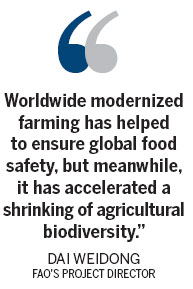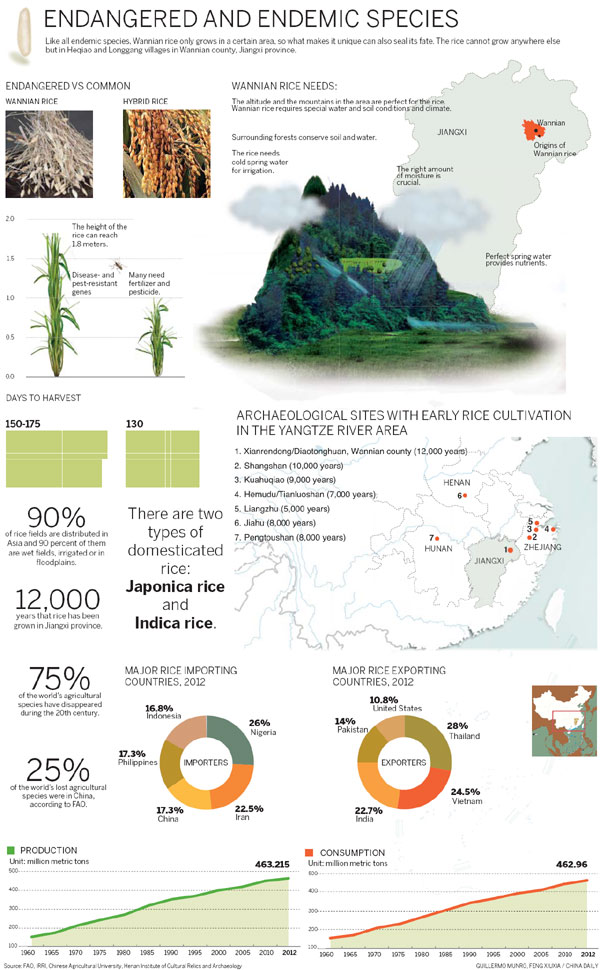Rice of ages
Updated: 2013-01-30 07:43
By Jin Zhu (China Daily)
|
||||||||
An heirloom species of this staple grain thrives only in a tiny pocket of East China, but scientists say its potential could be huge, Jin Zhu reports in Wannian, Jiangxi province.
Twenty hectares of arable land, tucked away in a mountain valley in Jiangxi province, may have a role to play in solving the worldwide food shortage.
A kind of rice that locals call Wuyuanzao has been grown in Wannian county in northeastern Jiangxi for more than 12,000 years.
The age-old rice variety is precious in the eyes of agriculture professionals. But Wu-yuanzao, commonly known today as Wannian rice, can only thrive in the county's Heqiao and Longgang villages, which are near Poyang Lake.
Experts believe this is because of the combination of cold spring water, special soil conditions and microclimate that are particular to the two villages.
The surrounding forests also play a crucial role in soil and water conservation, experts say, while the precious farmland planted with ancient rice is crowned by mist thanks to the moisture in the air.
Wannian rice has some advantages over other rice species.
It can reach 1.8 meters while ordinary rice grows less than 1 meter high.

Also, there is no need for pesticides or chemical fertilizers since this "heirloom" rice variety has proven resistant to insects and over centuries has adapted to low soil fertility.
Wannian rice also delivers richer nutrition than many other varieties, since it contains high levels of protein and vitamin B.
Its growing period is 160 to 175 days - much longer than the 130-day period for ordinary rice varieties. But scientists hope that cross-breeding the ancient rice with varieties that grow faster and adapt to more climates can produce a commercially viable hybrid rice that can feed many more people.
Zhan Ziyong, a local agriculture technician in Wan-nian county, notes that because of its sticky texture, the rice is particularly delicious when used to cook congee - the common porridge of South China.
According to historical records, in 1512 the county head brought some Wannian rice to the emperor of the Ming Dynasty (1368-1644). The emperor applauded the county's tribute to the royal family.
In the 1990s, a team of Chinese and US archaeologists made headlines by proving that two sites in the county, Xianrendong and Diaotonghuan, were among the origins of the world's rice.
As the researchers dug at the site, they found phytoliths of cultivated rice. These mineral secretions by plants - particularly silica - help scientists reconstruct what plants were present at a site centuries after the organic matter has decayed and dissipated.
The findings pushed back the world's historical dating of rice domestication from 7,000 years ago to about 12,000 years ago.
"Wannian rice's original germplasm resource needs to be protected for rice breeding in the future," says Min Qing-wen, an agricultural researcher from the Institute of Geographic Sciences and Natural Resources Research under the Chinese Academy of Sciences.
The importance of China's research into germplasm resources for hybrid rice has been well-established by prominent Chinese scientist Yuan Longping in the country's central Hunan province.
The original seed resources for his productive hybrid rice came from a field of wild rice now preserved in Sanya, Hai-nan province.
Rice is the staple food for more than 50 percent of the world's population and about 60 percent of China's 1.3 billion people.
Experts believe agricultural species resources are at risk in the face of the world's common threats, such as environmental pollution, climate anomalies and the invasion of alien species.
The Food and Agriculture Organization of the United Nations says 25 percent of species loss in the past century occurred in China, as the population and the exploitation of resources soared.
"Worldwide modernized farming has helped to ensure global food safety, but meanwhile, it has accelerated a shrinking of agricultural biodiversity," says Dai Weidong, FAO's project director.
In 2002, FAO initiated the Globally Important Agricultural Heritage Systems program to rescue traditional farming practices that survive in millions of poor rural communities worldwide.
The rice in Wannian county and its affiliated culture system was listed as an FAO global protection project in 2010.
Today, even in Wannian county, it is still rare to see the precious ancient rice outside the 20-hectare protected area. The cultivation area was more than 3,000 hectares as recently as 1950, according to local agricultural authorities.
"Lower output and huge labor input - because of traditional farming methods that the rice has - led more young people to abandon the self-sufficient lifestyles of their forefathers and go to work in cities," Zhan says.
The ancient rice produces 3 tons per hectare, compared to the average 9 tons per hectare for the ordinary rice varieties in one season, local figures show.
Local officials have raised the purchasing price for Wannian rice to three times the price of ordinary rice, to encourage farmers to keep planting it.
"But now I am still quite worried that no one will be willing to plant the ancient rice in the future. Then the rice variety is very likely to vanish," Zhan says.
Contact the writer at jinzhu@chinadaily.com.cn.

(China Daily 01/30/2013 page19)

 In Photos: 7.0-magnitude quake hits Sichuan
In Photos: 7.0-magnitude quake hits Sichuan
 Li Na on Time cover, makes influential 100 list
Li Na on Time cover, makes influential 100 list
 FBI releases photos of 2 Boston bombings suspects
FBI releases photos of 2 Boston bombings suspects
 World's wackiest hairstyles
World's wackiest hairstyles
 Sandstorms strike Northwest China
Sandstorms strike Northwest China
 Never-seen photos of Madonna on display
Never-seen photos of Madonna on display
 H7N9 outbreak linked to waterfowl migration
H7N9 outbreak linked to waterfowl migration
 Dozens feared dead in Texas plant blast
Dozens feared dead in Texas plant blast
Most Viewed
Editor's Picks

|

|

|

|

|

|
Today's Top News
Live report: 7.0-magnitude quake hits Sichuan, heavy casualties feared
Boston suspect cornered on boat
Cross-talk artist helps to spread the word
'Green' awareness levels drop in Beijing
Palace Museum spruces up
First couple on Time's list of most influential
H7N9 flu transmission studied
Trading channels 'need to broaden'
US Weekly

|

|







